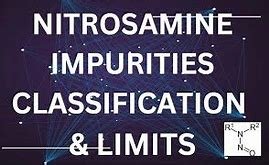Explore the challenges in determining acceptable intake (AI) limits for Nitrosamine Drug Substance-Related Impurities (NDSRIs) in pharmaceutical safety assessments.
Approaches and challenges for defining acceptable intake (AI) limits of nitrosamine drug substance-related impurities (NDSRIs).
Defining allowable impurities is critical task for assuring patient safety in the complex world of pharmaceutical regulation. An example of thisy is defining AI limits for a special class of impurities frequently identified in drug products namely, Nitrosamine Drug Substance-Related Impurities (NDSRIs). Compared to small molecule nitrosamines, NDSRI present unique challenges due to the compound specific nature of these substances, complicating their safety assessment.
Very Specific Problem: Impurities Related to the Compound
When it comes to NDSRIs, they are tightly coupled with the structure of each Active Pharmaceutical Ingredient (API), and that presents a challenge because there is little safety data out there. Compared to established nitrosamines, most newly detected suspected respiratory irritants possess untethered safety thresholds or AIs. Adding complexity to this situation, there is a lack of mutagenic and carcinogenic data for NDSRIs.
AI limits are important safety indicators, indicating levels that are considered safe for patients with no impurities. A compound-specific AI limit is frequently calculated based on estimates of carcinogenic potency, yet for many NDSRIs such data remain sparse and therefore poses a challenge. To answer this, the FDA has used quantitative Structure-Activity Relationship (SAR) methods. These approaches exploit data from well-defined surrogate compounds that are structurally and reactively related to NDSRIs.
Utilising Scientific Knowledge: SAR and Read–Across
When at least one mutation, the mutagenic potential is still insufficiently characterized, SAR methods are called upon. Such strategies entail the identification of structurally related compounds with existing carcinogenicity data. Based on these surrogates, it is possible to arrive at an empirical estimate of carcinogenic potency for the NDSRI lacking direct training data using a science-informed extrapolation model.
Finding the Right Fit in a Surrogate: The Balancing Act
Selecting the surrogate for a read-across analysis is critical. This decision is influenced by structural similarity, steric effect, electronic nature and metabolic activation. The structural environment of the surrogate’s N-nitroso group provides a useful guiding principle to ensure that behavior of the surrogate correctly reflects that of the NDSRI in question.
To Push the Barriers of Regulation Forward More
Alongside scientific development, our knowledge of NDSRI AI boundaries progresses. It requires coordinated actions between regulators, industry associations and researchers. By sharing and helping generate data, we enrich our knowledge base allowing us to make better decisions and innovate.
Conclusion
The pharmaceutical world will have to keep scientific breath with the flexibility of working within NDSRI AI limit determination. However, such difficulties act as a springboard to further improve methodologies and pave the way for safer and optimally informative drug development to ensure minimal patient adverse effects across the globe.
Contact BioBoston Consulting or visit us online and learn more about how we can help your organization.


